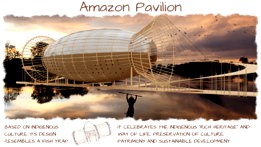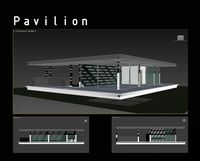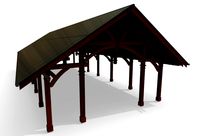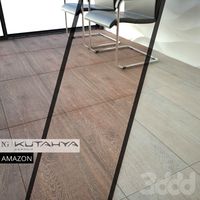GrabCAD

AMAZON PAVILION
by GrabCAD
Last crawled date: 1 year, 2 months ago
AMAURI GASPAR CONCEPTUALIZES AMAZON PAVILION
Located on the banks of the Amazon River, Amauri Gaspar visualizes a fish-trap shaped pavilion which preserves and revives the memory of indigenous culture. Celebrating the community’s rich heritage and way of life, the large curving structure houses within it facilities to preserve the region’s rich marine and bio diversity, united with distinctive tourism experiences.
Boasting simple vernacular architecture — emblematic of a synthesis of man’s relationship with nature in the Amazon — the pavilion is clad with weaving, latticed wicker that emulates the traditional handicraft technique of basketware in a delicate constructional expression. Gaspar tops the complex with a PET roof integrated with photovoltaic cells for renewable energy. The complex also floats on stilts to adapt to the stark changes in the Amazon River’s water levels throughout the year.
A FLOATING COMPLEX TO PRESERVE LOCAL BIODIVERSITY
Fluidly adaptable, the Amazon Pavilion floats to adjust to the fluctuating water levels and stark shift in seasons. ‘You don’t fight with the water, you live with it,’ notes designer Amauri Gaspar. The island experiences two very different seasons, causing opposing living situations for the residents. For the full season from March to August — an ideal time to visit the Igapos — water levels rise to 15 meters. During the dry season from September to February, river levels reach their lowest point, which reduces space for fish and makes fishing and alligator spotting much easier.
In response, the pavilion’s foundations are ceramic tables filled with reeds, deemed unsinkable to deal with the rising sea levels. The designer attaches rings around the pillars and stakes to stabilize the complex and ensure it stays in its place despite the floating motions of the building.
LADEN WITH THE MEMORY OF INDIGENOUS HERITAGE
The project memorializes the memory and lifestyle of indigenous people — a community that fought for its land, its diversity, and its historic customs — with a heritage and sustainable development scheme. Representing only less than 5% of the world’s population, indigenous communities protect 80% of global biodiversity. As such, the pavilion is dedicated to preserving the natural elements of the region, incorporating farming and marine areas, algae cultivation and bio energy spaces.
Further, the complex generates an equal hierarchy for its program, drawing on indigenous society’s
Located on the banks of the Amazon River, Amauri Gaspar visualizes a fish-trap shaped pavilion which preserves and revives the memory of indigenous culture. Celebrating the community’s rich heritage and way of life, the large curving structure houses within it facilities to preserve the region’s rich marine and bio diversity, united with distinctive tourism experiences.
Boasting simple vernacular architecture — emblematic of a synthesis of man’s relationship with nature in the Amazon — the pavilion is clad with weaving, latticed wicker that emulates the traditional handicraft technique of basketware in a delicate constructional expression. Gaspar tops the complex with a PET roof integrated with photovoltaic cells for renewable energy. The complex also floats on stilts to adapt to the stark changes in the Amazon River’s water levels throughout the year.
A FLOATING COMPLEX TO PRESERVE LOCAL BIODIVERSITY
Fluidly adaptable, the Amazon Pavilion floats to adjust to the fluctuating water levels and stark shift in seasons. ‘You don’t fight with the water, you live with it,’ notes designer Amauri Gaspar. The island experiences two very different seasons, causing opposing living situations for the residents. For the full season from March to August — an ideal time to visit the Igapos — water levels rise to 15 meters. During the dry season from September to February, river levels reach their lowest point, which reduces space for fish and makes fishing and alligator spotting much easier.
In response, the pavilion’s foundations are ceramic tables filled with reeds, deemed unsinkable to deal with the rising sea levels. The designer attaches rings around the pillars and stakes to stabilize the complex and ensure it stays in its place despite the floating motions of the building.
LADEN WITH THE MEMORY OF INDIGENOUS HERITAGE
The project memorializes the memory and lifestyle of indigenous people — a community that fought for its land, its diversity, and its historic customs — with a heritage and sustainable development scheme. Representing only less than 5% of the world’s population, indigenous communities protect 80% of global biodiversity. As such, the pavilion is dedicated to preserving the natural elements of the region, incorporating farming and marine areas, algae cultivation and bio energy spaces.
Further, the complex generates an equal hierarchy for its program, drawing on indigenous society’s
Similar models
grabcad
free

WINE PAVILION - ARCH: AMAURI GASPAR
...wine pavilion - arch: amauri gaspar
grabcad
wine pavilion - arch. amauri gaspar
grabcad
free

AUTOMATON WHALE - ARCH. AMAURI GASPAR
...automaton whale - arch. amauri gaspar
grabcad
automaton whale - arch. amauri gaspar
grabcad
free

BED KOKESHI - ARCH. AMAURI GASPAR
...bed kokeshi - arch. amauri gaspar
grabcad
bed kokeshi - arch. amauri gaspar
3dwarehouse
free

Water level ruler - flood and dry season for river
...water level ruler - flood and dry season for river
3dwarehouse
water level ruler - flood and dry season, river, sea
grabcad
free

ALMA
...alma
grabcad
arch. amauri gaspar
grabcad
free

pasta
...pasta
grabcad
arch. amauri gaspar
grabcad
free

ANEMONE
...anemone
grabcad
arch. amauri gaspar
3dwarehouse
free

Bishop's Palace in Kilkenny
...of ireland’s national heritage and to highlight its importance to public policy and everyday life. http://www.heritagecouncil.ie/
grabcad
free

bed Chaplin
...bed chaplin
grabcad
bed chaplin arch. amauri gaspar
3dwarehouse
free

floating containers converted to a center for visitors to the amazone river in brazil
... the area. meant to be part of reeducating people to preserve nature #tensile_structure #tensined_structure #textile_architecture
Pavilion
3d_export
free

Pavilion
...pavilion
3dexport
pavilion
archibase_planet
free

Pavilion
...pavilion
archibase planet
pavilion stall booth
pavilion n160211 - 3d model (*.gsm+*.3ds) for exterior 3d visualization.
3d_ocean
$25

Pavilion
...an
architecture barcelona house modern pavilion reflection stone travertine water white
pavilion , modern architecture,3dmax 2012
3d_ocean
$8

Ancient Pavilion
...odel pavilion roman sumerian
this is an a 3d model of an ancient pavilion, originally modeled to be an ancient egyptian pavilion.
turbosquid
$35

Pavilion
...id
royalty free 3d model pavilion for download as ma and obj on turbosquid: 3d models for games, architecture, videos. (1517738)
3d_export
$5

pavilion
...pavilion
3dexport
3d_export
$5

Pavilion
...pavilion
3dexport
3d_export
free

pavilion
...pavilion
3dexport
turbosquid
$29

Pavilion
...ee 3d model pavilion for download as blend, dae, fbx, and obj on turbosquid: 3d models for games, architecture, videos. (1563474)
turbosquid
$55

pavilion
... available on turbo squid, the world's leading provider of digital 3d models for visualization, films, television, and games.
Amazon
turbosquid
$5

Amazone
...d
royalty free 3d model amazone 3d model for download as max on turbosquid: 3d models for games, architecture, videos. (1580848)
turbosquid
$12

amazon
...model amazon for download as max, max, max, max, obj, and fbx on turbosquid: 3d models for games, architecture, videos. (1649213)
turbosquid
free

AMAZON Necklace
...turbosquid
free 3d model amazon necklace for download as stl on turbosquid: 3d models for games, architecture, videos. (1337872)
3ddd
$1

KUTAHYA SERAMIK AMAZON
...14, 2013, 2011,
obj
_____________________________________http://www.ngkutahyaseramik.com.tr/en/products/seramik/amazon/
turbosquid
free

Amazon Statue
...id
free 3d model amazon statue for download as dwg and sldpr on turbosquid: 3d models for games, architecture, videos. (1215520)
turbosquid
$59

Amazon Warrior
...ee 3d model female amazon warrior for download as obj and ztl on turbosquid: 3d models for games, architecture, videos. (1353643)
turbosquid
$40

Amazon Girl
... available on turbo squid, the world's leading provider of digital 3d models for visualization, films, television, and games.
3d_ocean
$15

Amazon Fire Phone
... ebay fire htc ios ipad iphone ipod justtomas model nokia phone samsung windows
amazon fire phone by justtomas .c4d r12 .3ds .obj
turbosquid
free

Amazon Echo Studio
...bosquid
free 3d model amazon echo studio for download as fbx on turbosquid: 3d models for games, architecture, videos. (1679075)
turbosquid
$10

Amazon Fire HD
...d
royalty free 3d model amazon fire hd for download as blend on turbosquid: 3d models for games, architecture, videos. (1201417)
